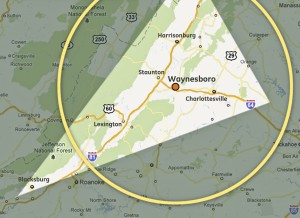Why Waynesboro?
The history and importance of the South River


The South River and paths along its banks connected Indian villages in the Shenandoah Valley. Another Indian trail crossed the Blue Ridge at Rockfish Gap. The two met at the river, where in 1739 Joseph Teas purchased 465 acres and opened a tavern in what would become the town of Waynesboro.
By the 1750s the Shenandoah Valley was filling with immigrants from Pennsylvania and New England. They found rich farmland, streams teeming with fish, and Waynesboro springs that never went dry.
Mills powered by water sawed timber into lumber. In 1828 Moses Alexander began manufacturing furniture and caskets. Grist mills dotted streams in the valley.
Iron ore abounded in the mountains, the valley was underlain by limestone, and the forest provided wood for charcoal. Rock chimney furnaces smelted the ore into pig iron which was floated in narrow wooden boats down the Shenandoah River to Harper’s Ferry.
Rails follow the river north and south. But in 1858 the Crozet Tunnel under Rockfish Gap opened Waynesboro to east-west rail traffic. The city became a hub.
In 1884, the Rife Hydraulic Engine Manufacturing Company which made water pumps that did not require electricity opened a foundry in Waynesboro. The foundry continued to manufacture pumps into the 1950s, and one of its pumps at a dam recently removed from the South River provided water for the city.
The Waynesboro Chamber of Commerce was established in 1923 and immediately launched “Water, Weather, Wheels, and Workers,” a campaign to attract industry.
It was successful. In 1927 Crompton-Shenandoah, attracted by free use of 2,000 gallons per day of spring water, located on South River’s west bank. A year later, DuPont purchased 153 acres across the river to manufacture rayon, a process that required huge quantities of fresh water.
LYCRA was invented by DuPont scientists and began commercial production in Waynesboro in 1962. DuPont’s facilities were acquired by Invista, a subsidiary of Koch Industries, which supplies the fabric to customers throughout the world.
Today new industry, in the form of tourism, is wetting its roots in the same waters that have sustained the city from the days of Teas’ Tavern.
